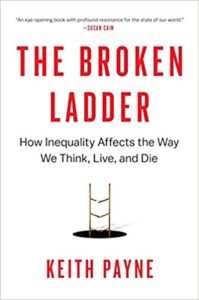
A pair of epidemiologists, Richard Wilkinson and Kate Pickett, wanted to know how economic factors impacted health and social problems in several developed nations. When they made a graph with one axis showing average income and the other showing an index of health and social problems, the countries formed an amorphous cloud with no discernible pattern. But when they swapped the average income for a measurement of inequality, a clear correlation appeared: regardless of income, the countries most likely to have health and social problems were the most unequal ones, with the United States of America worst off of all.
This information appears early on in The Broken Ladder by Dr. Keith Payne, a professor of Psychology at the University of North Carolina-Chapel Hill. His new book focuses on the psychological impact of economic inequality. He makes every effort to legitimize the conversation and include people who might otherwise disagree with his conclusions. Inequality, in Payne’s eyes, is massively detrimental to everyone in unequal societies, and everyone needs to know it.
Payne’s chapter on politics is both illuminating and confounding. After debunking the myth that the Republican Party’s voter base is poorer than the Democratic Party’s voter base (using analysis of the 2004 Presidential election), he moves on to how inequality is correlated with partisanship, measured by the frequency with which Congresspersons vote against one another (the short version: it’s very correlated). He says conservatives believe “that a society in chaos is the worst possible condition.” This, in reference to the tendency of Republicans to work towards the preservation of the status quo, seems a little outdated, at best. Payne does little to account for the causes of inequality in this chapter, but he ends it with a plea for peace.
In 2014, about a third of respondents [to a Pew Research Center poll] thought that members of the opposite party were not just mistaken, but were a threat to the nation’s well being… These trends are dangerous because when opponents become enemies, people can justify almost anything in responding to them.
Certainly, what the poll found is not indicative of a healthy political climate. And treating political parties like teams to whom one bears unwavering allegiance is bad. But calling one party a “threat to the nation’s well-being” is not inherently silly; it could be accurate. And The Broken Ladder is extremely good evidence of exactly that.
Payne’s writing on how inequality changes people’s decisions, beliefs, and even their health is eye-opening and efficient. Each piece is explained clearly, and he has a useful tendency to layer the information from the relevant studies in such away that it creates a narrative and intellectual flow. These sections are well crafted and informative, but perhaps the best chapter in the book is the one on racial inequality.
He starts by explaining the different perceptions that white people and black people have in terms of how much discrimination each race faces.
Whites seemed to view discrimination as a zero-sum game: The less discrimination they perceived against blacks, the more they saw it turned against whites. The trend was so stark in the eyes of white respondents that by the 2000s they judged discrimination against whites to be a bigger problem than discrimination against blacks.
Payne then cites a variety of studies on an array of subjects—job applications and prison sentencing among them—that prove conclusively that this is not the case, that black people still face much more discrimination than white people do. The barrage, for those who do not need to be convinced, can be arduous, but it has to be proved. He adds further nuance by highlighting studies that show when white people feel that their social or economic positions are diminishing for any reason, they act more racist. It is not tied, necessarily, to their material conditions, but their perceptions of their material conditions.
The last piece of Payne’s puzzle comes from a study he cites by political scientist Martin Gilens, which found that “the best predictor of wanting to slash funding for welfare recipients is racial prejudice.” Here is where the value of his evenhandedness becomes obvious. There are moments in the book when his concessions, for someone already convinced that inequality is major issue, can feel unnecessary. Without that approach, though, the argument he makes about racism might not be possible. A deliberate and detailed explanation of how racism impacts economic inequality is necessary, and the slow pace is necessary for it to land with everyone who reads the book.
The Broken Ladder is a clear and useful book about the gap between the society we have and a society we want. It’s an important step toward understanding how these complicated issue affect our country—alongside books like Matthew Desmond’s Evicted, which takes a more narrative approach to the issue, and Per Molander’s The Anatomy of Inequality, which analyzes it from an economic point of view.
Inequality can seem intractable, but these writers are steering us in the right direction. It is no doubt difficult to situate the problem of inequality in such a fraught political landscape, with a President so intent on hurting so many, but keeping an eye on a long-term vision of a more egalitarian society is necessary, too. Keeping Payne’s book on your bedside table is a good place to start.




